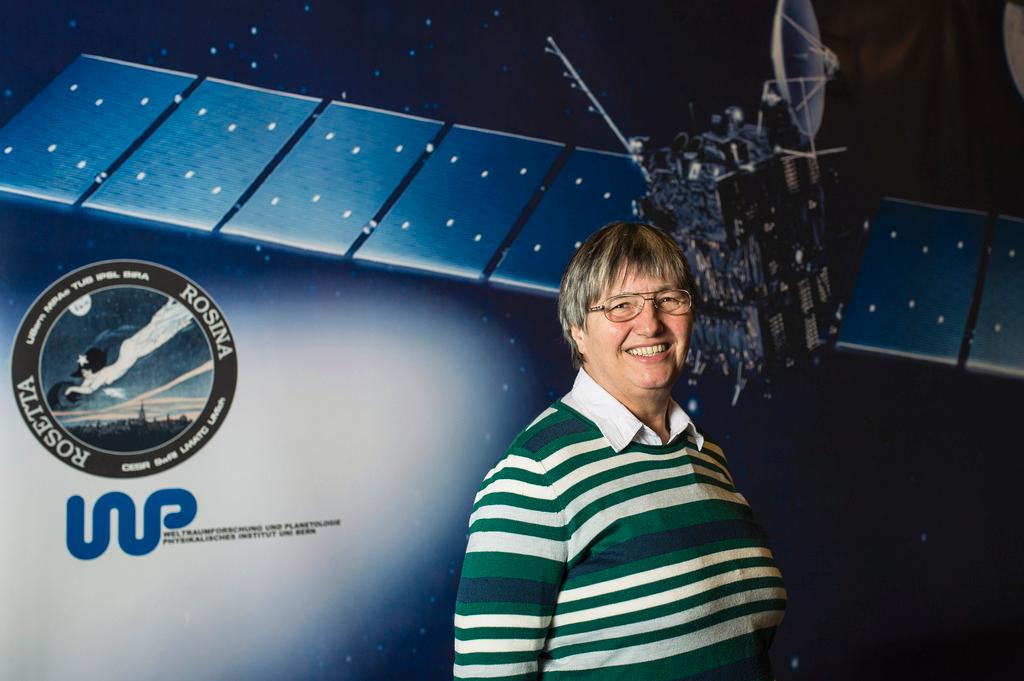Creating the soundtrack for the universe

StarMaker, Quantum Chaos, Photons: looking at the names of the tracks on Ben Moore’s latest electro-rock album, you might get some clues as to his day job.
The British-born MooreExternal link is a professor of astrophysics at the University of Zurich, working with supercomputers. But he also has a passion for communicating his love of science to the public through books, music and film.
I boldly went to visit Moore in his latest incarnation: scientist in residence at the Rietberg Museum in Zurich, which is hosting the Cosmos – an Enduring MysteryExternal link exhibition on creation myths and the beginnings of European research into the universe. Moore, who is in his 40s, is waiting for me inside the museum’s darkened rooms. In trainers, jeans and hip glasses, he doesn’t look like your average astrophysicist.
What does he make of the exhibition? “It brings together wonderful artefacts from all over the world from different time periods,” he says. “And it shows the imaginations that humans have to make up stories about our world and the cosmos around us.”

More
Universally appealing
Moore is particularly interested in the original textbooks by Galileo, the first to point a telescope up at the stars, and Copernicus because “he brought back the Greek ideas that the sun was at the centre of our solar system”.
The final frontier
So how far are we now in our understanding? “In the last 100 years with modern cosmology we’ve really discovered our place in the universe, that we live in a universe that is 13.8 million years old, tens of billions of light years across and contains hundreds of billions of galaxies.
“And we have realised that our own milky way is not special. It’s just one of many countless other galaxies out there in our universe.”
But the mystery of the universe, to echo the exhibition’s title, is still not fully explained. “That’s a question which might not be solved for many more generations of scientists. It’s a hard question.”
What Moore has managed to do, in a special film for the exhibition, is to explain the history of the universe as we now understand it, in 24 hours.
On this timescale the sun and the solar system only appear in the late afternoon. And we humans appear very late indeed.
“All of recorded human history takes place in the final second before the end of the day,” Moore said. Overall, we understand quite well the history of the universe, back to a fraction of a second after the Big Bang. “It’s that first fraction of a second that we don’t understand yet.”
Supercomputers
Moore has been in Switzerland for 12 years, His own scientific workExternal link is mainly based around supercomputing, to try and understand how stars, planets and galaxies formed.
The relevant maths and physics are programmed in and the computer gets to work. Back in his office at the museum, he explains what happens next. “At the end after several months of waiting perhaps you will then take your computer simulation and compare it to the real universe to see if you have a model that matches the observations.”.
His fascination for the universe is, probably, Moore admits, “the same as many people’s, just to understand more about where we came from and where we are going”.
But he has a real drive to explain it to the wider public. Indeed, one of his duties as scientist in residence at the museum – and which was next on his agenda after this interview – was “A Cup of Tea with Ben Moore” in the museum’s cafe, in which people could ask him all manner of cosmos questions, such as “Is time travel possible?” or, even, “What did you think of the movie Interstellar?”
Little Green Men?
Moore is also using his residency to work on his next project: a science fiction book, a new direction after two popular science books: his first: Elephants in SpaceExternal link (2012), about the history and future of life in our universe, made the Swiss bestseller lists. His second Da draussen – Leben auf unserem Planeten und anderswo,External link (Out there, life on our planets and elsewhere, 2014) deals with that perennial fascination: aliens.
Where we might think of Little Green Men or marauding, attacking beings, Moore remains more open.
“Hollywood has burned in this picture of an alien as a four limbed symmetric bipedal creature rather like a human and the reality could be far different,” he said. “There are hundreds of thousands of species with brains on our planet, any of which might develop the intelligence to become the next overlords of planet earth.”
“So you can just use your imagination for what aliens might be like. They are probably symmetric because for things that move, it’s a benefit to be symmetrical. But perhaps aliens are like an octopus – very smart creatures with the brain distributed throughout their bodies, it’s a possibility.”
Rocking the universe
And of course, the universe is never far from his music as well. Under his artist name “Professor Moore”, Moore plays guitars with the electro-rock band Milk67 and has recently released his first solo album, Escape VelocityExternal link, excerpts of which you can hear in our podcast.

More
The universe at midnight
One of his favourite songs on the album is StarMaker. “It incorporates a sound in there, the sound of the big bang in the transition, the drop, and that’s really the noise that you could hear if your ears were the size of the universe.”
He describes his style as electro rock, with all songs built around guitar melodies. Moore himself has been playing the guitar since he was 14 years old, growing up in northern England. His lists his influences as heavy metal, grunge – discovered during a stint in research in the United States – and house music, particularly French.
His adopted homeland is also represented. The lyrics to Contact, for example, are in the Swiss minority language of Romansh, and sung by Jusht, a rapper with the Graubünden band Liricas Analas.External link
“I make music because it makes me happy and also it makes me happy when other people like my music of course,” Moore explained “It’s a form of relaxation as well.”
And something to listen to while pondering the mysteries of the universe.
Ben Moore (1966) was born in Northumberland in northern England. He gained his PhD from the University of Durham. He spent several years as a research fellow in the United States. He now works for the Centre for Theoretical Astrophysics and Cosmology at the University of Zurich.
The professor has authored over 200 scientific papers ranging from the origins of planets and galaxies to dark matter and dark energy.
A children’s book answering questions form a school class in Zurich is due to come out in the summer.
He once had a float at the 2010 Zurich Street Parade with his band.

In compliance with the JTI standards
More: SWI swissinfo.ch certified by the Journalism Trust Initiative












You can find an overview of ongoing debates with our journalists here . Please join us!
If you want to start a conversation about a topic raised in this article or want to report factual errors, email us at english@swissinfo.ch.